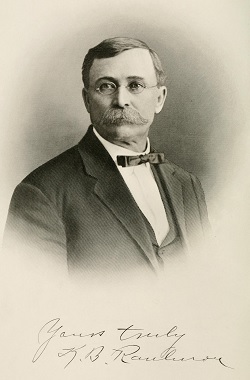
 Very few people outside of those interested know anything of the magnitude of the cattle industry in
Florida. When the stranger hears of men in Florida owning five, ten and twenty thousand head of
cattle, he puts it down as a fable, because these immense herds are associated in his mind with the
vast ranges of Texas, Wyoming, Montana, and the western plains States. But Florida was in the cattle
business when these States were ranged over by Indians, trappers and buffalo. As far back as 1850,
Florida was raising more cattle than the local population could use, and was also exporting the
surplus to the West Indian Islands. From that day on the business has been of large proportions. Up
to a comparatively recent period, it has been the leading industry of the southern half of the
peninsula, as it was the very first business out of which ready money could be made in a remote
section distant from any markets. The cattle could be driven on their own legs to the market, which
made the industry a preferred one to those things requiring transportation by the slow methods
prevailing forty and fifty years ago. In one ten-year period Florida exported to Cuba $7,000,000
worth of cattle. In a later five year period, $2,600,000 worth were exported. This was entirely
above and beyond the local consumption.
Very few people outside of those interested know anything of the magnitude of the cattle industry in
Florida. When the stranger hears of men in Florida owning five, ten and twenty thousand head of
cattle, he puts it down as a fable, because these immense herds are associated in his mind with the
vast ranges of Texas, Wyoming, Montana, and the western plains States. But Florida was in the cattle
business when these States were ranged over by Indians, trappers and buffalo. As far back as 1850,
Florida was raising more cattle than the local population could use, and was also exporting the
surplus to the West Indian Islands. From that day on the business has been of large proportions. Up
to a comparatively recent period, it has been the leading industry of the southern half of the
peninsula, as it was the very first business out of which ready money could be made in a remote
section distant from any markets. The cattle could be driven on their own legs to the market, which
made the industry a preferred one to those things requiring transportation by the slow methods
prevailing forty and fifty years ago. In one ten-year period Florida exported to Cuba $7,000,000
worth of cattle. In a later five year period, $2,600,000 worth were exported. This was entirely
above and beyond the local consumption.
Our subject, K. B. Raulerson, of Fort Pierce, is a cattle man, and though he still adheres to
the primary industry of the State, he is a thoroughly up-to-date citizen upon all questions of
modern import. Mr. Raulerson, like most of the men engaged in the cattle business, is a native of
the State. He was born at Seville, in Volusia county, on September 19, 1861. The family is of Welsh
descent and their first progenitor in this country settled in Georgia. Wade H. Raulerson, the father
of K. B. moved from Georgia to Florida in 1858 and married Katherine Hart of Seville, Fla. Young
Raulerson obtained such education as the public schools at Geneva, Fla., could give him, and in
1881, then barely grown, he engaged in farming and stock raising in Orange county, Fla. With growing
knowledge and larger capital he concentrated his energies, in 1896, in the cattle business, and in
1903 organized the East Coast Cattle Company, of which he has since been the president. Mr.
Raulerson is a thoroughly capable man in his line, who has worked himself forward to a position of
prominence in the community and is recognized as one of the substantial men of St. Lucie county. He
has served his county as a Commissioner for one term and was for three terms Chairman of the
Democratic executive committee of Brevard county before St. Lucie county was cut off from Brevard.
Mr. Raulerson has been twice married. First, to Miss Elizabeth Randolph, a daugher of Lucius and
Isidore (Preston) Randolph. His second wife was a widow, Mrs. Erne Alderman, who was the daughter of
Eli O. and Lucy (Geiger) Morgan, of Florida.
In politics Mr. Raulerson is identified with the Democratic party and is a communicant of the
Methodist Church. He is associated with the Board of Trade of Fort Pierce, and is a live member of a
live organization in a live town, and unless all the signs fail, Fort Pierce has before it an even
larger future than its most sanguine friends now anticipate. To that future Mr. Raulerson, yet in
the prime of life, will undoubtedly contribute his full share. Upon questions of public importance
affecting his State, Mr. Raulerson believes that the convict lease system should be abolished, that
the convicts should be worked on public roads and that the Everglades should be drained. In this
last opinion of his there seems to be some differences even between intelligent men in Florida, but
to the impartial outsider it appears a very sound position. If the 5,000,000 acres of extremely rich
muck land now covered by the Everglades could be brought under cultivation, the development of that
great acreage in sugar farms would yield enough sugar to supply every pound of the millions of tons
used by the United States and would carry into Florida the one hundred millions of dollars we now
pay each year for the sugar imported from abroad.
Contributed 18 Aug 2020 by Norma Hass from 1909 Makers of America, An Historical and Biographical Work by an Able Corps of Writers, Volume 3, pages 320-322.
Volusia County FLGenWeb ©2019 – Design by Templates in Time